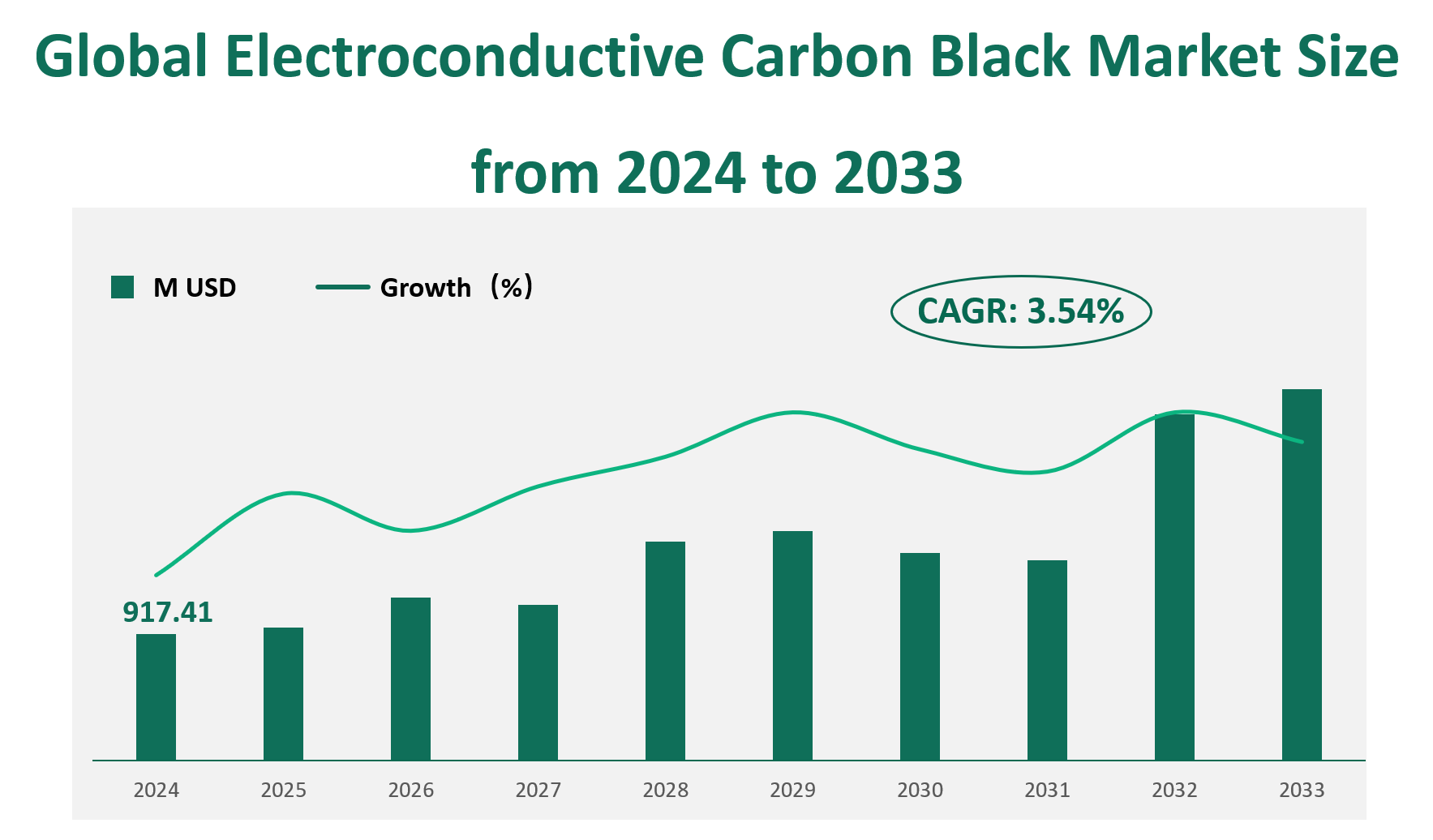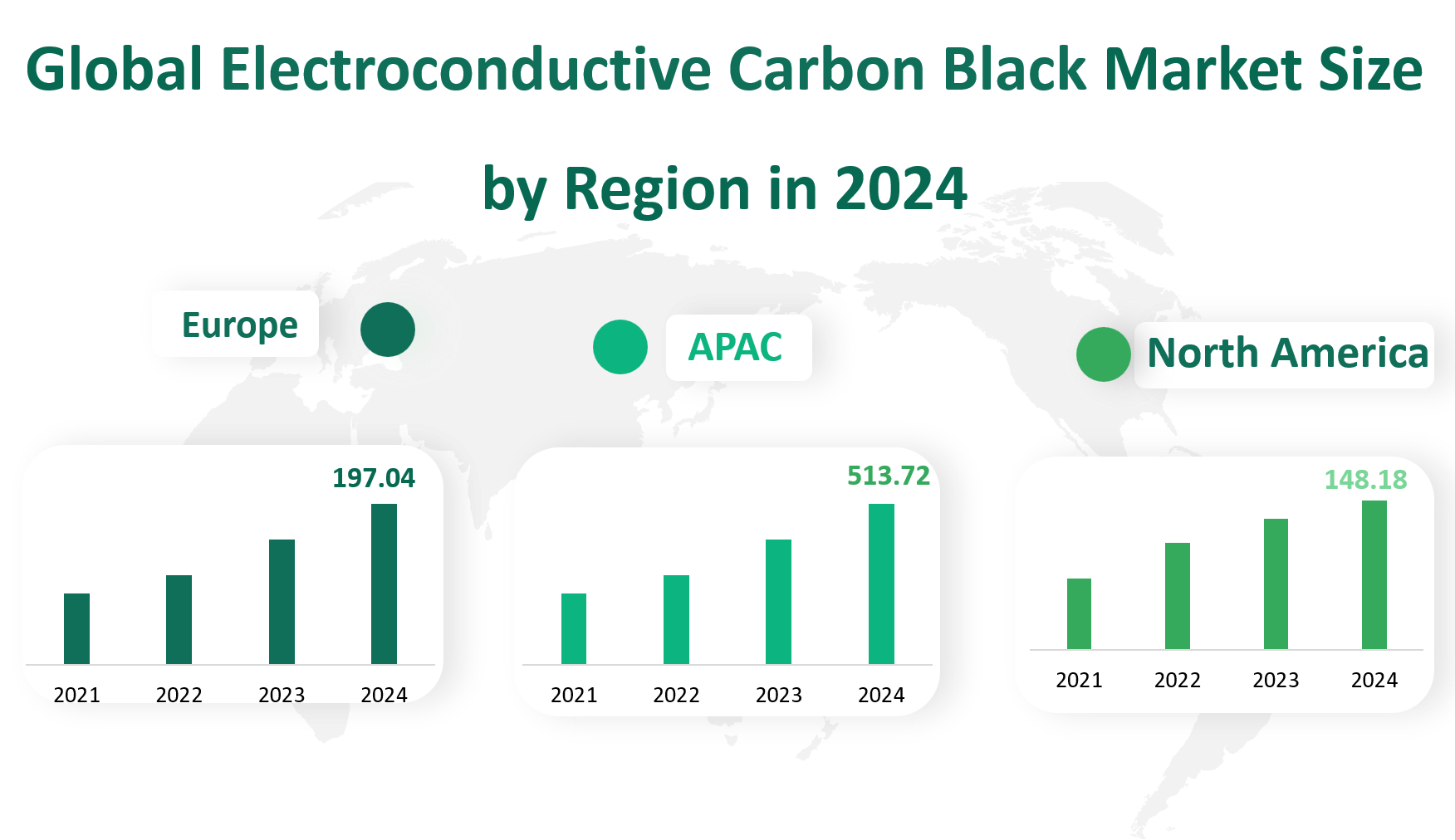1. Global Electroconductive Carbon Black Market Revenue and Future Growth
The global Electroconductive Carbon Black market is projected to reach 917.41 million USD in 2024. This growth is driven by a consistent Compound Annual Growth Rate (CAGR) of 3.54% from 2024 to 2033.
Electroconductive Carbon Black is a specialized form of carbon black designed to impart electrical conductivity to materials such as plastics and rubbers. Unlike ordinary carbon black, it has a significantly lower resistivity, making it an essential additive for applications requiring conductivity or antistatic properties. Its unique properties stem from its high surface area and ability to form conductive networks within insulating polymers. This material is crucial for industries ranging from electronics and automotive to aerospace and defense, where conductivity and static dissipation are critical.
Figure Global Electroconductive Carbon Black Market Size (M USD) and CAGR (2024-2033)

2. Driving Factors and Limiting Factors of Electroconductive Carbon Black Market
The growth of the Electroconductive Carbon Black market is influenced by several key factors. One of the primary drivers is the increasing demand from downstream industries, particularly in plastics, rubbers, and coatings. As industries such as automotive, electronics, and aerospace continue to expand, the need for materials with enhanced conductivity and antistatic properties grows. For instance, the development of electric vehicles and smart grids has spurred the demand for conductive materials in cable shielding and battery components.
Another significant driver is the rapid industrialization and economic growth in key regions such as Asia-Pacific, Europe, and North America. Policies promoting the development of advanced manufacturing and infrastructure, such as China’s “Made in China 2025” initiative and the push for smart grid technology, have further bolstered market demand. Additionally, the rise of e-commerce and online sales models has streamlined the distribution of Electroconductive Carbon Black, reducing transaction costs and improving market accessibility.
However, the market also faces several challenges. Environmental regulations and stricter production safety standards have pressured companies to invest in advanced technologies to meet compliance requirements. The high cost of raw materials, particularly coal tar and crude oil, poses a significant barrier to market expansion. Fluctuations in these prices can impact production costs and profitability, making it difficult for smaller players to compete.
3. Electroconductive Carbon Black Market Technology Innovation and Corporate Mergers and Acquisitions
The Electroconductive Carbon Black market is characterized by continuous technological innovation and strategic corporate activities. Companies are investing heavily in research and development to enhance product quality and develop new applications. For example, Imerys Graphite & Carbon has expanded its production capacity to meet the growing demand for specialty conductive additives in lithium-ion batteries. Similarly, Cabot Corporation’s acquisition of Tokai Carbon’s plant in Tianjin, China, highlights the strategic focus on expanding production capabilities and tapping into emerging markets.
Corporate mergers and acquisitions (M&A) are also shaping the market landscape. Major players such as Cabot Corporation and Denka are leveraging M&A to consolidate their market positions and expand their product portfolios. These strategic moves not only enhance their competitive edge but also drive industry integration, leading to a more consolidated market structure.
4. Global Electroconductive Carbon Black Market by Types
Electroconductive Carbon Black is a specialized form of carbon black that offers superior conductivity compared to conventional carbon black. It is widely used in industries where electrical conductivity or antistatic properties are required. The market for Electroconductive Carbon Black can be segmented into three primary product types: Conductive, Superconductive, and Extraconductive.
Conductive Carbon Black has a BET surface area of approximately 120 m²/g and an oil absorption number (OAN) of 100. It is designed to provide moderate conductivity and is often used in applications where basic electrical conductivity is required.
The market size for Conductive Carbon Black is forecasted to be USD 566.68 million in 2024. This type holds the largest market share due to its versatility and wide range of applications in industries such as plastics, rubbers, and coatings. Its moderate conductivity makes it suitable for a broad spectrum of products, contributing to its dominant position in the market.
With a BET surface area of around 250 m²/g and an OAN of 180, Superconductive Carbon Black offers higher conductivity than Conductive Carbon Black. It is used in applications that require more advanced electrical properties, such as in high-performance plastics and rubbers.
The market size for Superconductive Carbon Black is estimated at USD 281.68 million in 2024. While it has a smaller market share compared to Conductive Carbon Black, its growth rate is notable.
Extraconductive Carbon Black is the most advanced type, with a BET surface area ranging from 800 to 1200 m²/g and an OAN of 300–400. Extraconductive Carbon Black provides the highest level of conductivity and is used in specialized applications where superior electrical properties are essential.
The market size for Extraconductive Carbon Black is projected to be USD 69.05 million in 2024. Although it has the smallest market share, Extraconductive Carbon Black is experiencing rapid growth. Its high conductivity and specialized applications, such as in advanced electronics and high-performance materials, are fueling its expansion.
Table Global Electroconductive Carbon Black Market Size by Type in 2024
Type | Market Size (M USD) 2024 |
Conductive | 566.68 |
Superconductive | 281.68 |
Extraconductive | 69.05 |
5. Global Electroconductive Carbon Black Market by Applications
Electroconductive Carbon Black is used in resins to improve electrical conductivity and electromagnetic or thermo-conductive characteristics. It is also used for pigmentation in special printing inks, paints, and varnishes. The market size for Electroconductive Carbon Black in resins is USD 255.79 million in 2024.
In the rubber industry, Electroconductive Carbon Black enhances the electrical conductivity of rubber compounds, making them suitable for applications such as anti-static and conductive rubber products. The market size for Electroconductive Carbon Black in rubbers is estimated at USD 436.37 million in 2024. Rubbers account for the largest market share among all applications, driven by the growing demand for conductive and anti-static rubber products in industries such as automotive, industrial manufacturing, and electronics.
Electroconductive Carbon Black is used in paints to provide electrical conductivity and improve the overall performance of the coating. It helps in creating conductive or antistatic coatings for various industrial applications. The market size for Electroconductive Carbon Black in paints is USD 159.34 million in 2024.
Table Global Electroconductive Carbon Black Market Size by Application in 2024
Application | Market Size (M USD) 2024 |
Resins | 255.79 |
Rubbers | 436.37 |
Paints | 159.34 |
Others | 65.90 |
6. Global Electroconductive Carbon Black Market Size by Region
Asia-Pacific is the largest market by revenue, with an estimated revenue of 513.72 million USD in 2024. This region’s dominance is attributed to its rapid industrialization, particularly in countries like China and India, which have significant manufacturing sectors. The demand for Electroconductive Carbon Black in Asia-Pacific is driven by the growth in automotive, electronics, and construction industries.
The fastest-growing region is Latin America, with a projected revenue of 40.34 million USD in 2024. This region’s growth is driven by the increasing demand for conductive materials in the automotive and electronics sectors.
Europe, with a projected revenue of 197.04 million USD in 2024, remains a significant market due to its strong industrial base and advanced manufacturing capabilities. The region’s demand is driven by the automotive and aerospace industries, which require high-performance conductive materials.
North America, with a projected revenue of 148.18 million USD in 2024, is another key market. The United States, in particular, is a major consumer of Electroconductive Carbon Black, driven by its strong automotive and electronics industries.
The Middle East & Africa, with a projected revenue of 18.13 million USD in 2024, is a smaller but growing market. The region’s demand is driven by the automotive and electronics sectors, particularly in countries like Saudi Arabia and Turkey.
Figure Global Electroconductive Carbon Black Market Share by Region in 2024

7. Global Electroconductive Carbon Black Market Analysis by Major Players
Cabot Corporation is a leading global specialty chemical and performance materials company headquartered in Boston, Massachusetts. Established in 1882, the company has a strong presence in the Electroconductive Carbon Black market, with a revenue of $72.09 million USD in 2021.
Cabot offers a range of products, including BLACK PEARLS® 2000, STERLING® C, VULCAN® P, and VULCAN® XC72, which are designed for various conductive and anti-static applications. The company’s strength in research and development has enabled it to maintain a competitive edge in the market.
Denka, a Japanese chemical company established in 1915, is a major player in the Electroconductive Carbon Black market. With a revenue of $48.76 million USD in 2021, Denka offers “DENKA BLACK,” a highly purified acetylene black used in dry cells, cables, and electronic components. The company’s products are known for their high conductivity and thermal properties, making them ideal for various industrial applications.
Orion Engineered Carbons is a leading global supplier of carbon black, with a revenue of $43.65 million USD in 2021. Established in 1862, the company offers a broad range of carbon blacks, including specialty gas blacks, acetylene blacks, and furnace blacks. Orion’s products are used in polymers, plastics, paints, coatings, and other industrial applications. The company’s focus on innovation and quality has helped it maintain a strong market position.

